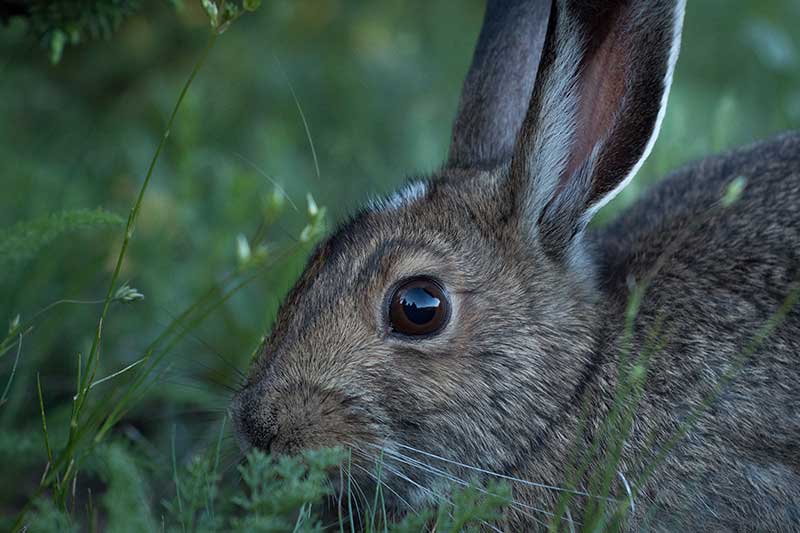Rabbits: abundant, small to medium-sized herbivores – or as one account puts it, a little ungenerously, ‘food-chain fodder’. But there’s more to rabbits than food for foxes and stoats and buzzards. These unassuming grazers are landscape engineers, a talent that wasn’t appreciated until we almost lost them.
Arriving in Britain
Rabbits (Oryctolagus cuniculus), like their taxonomic cousins, brown hares (Lepus europaeus), arrived in Britain in the tow of conquerors – brown hares with the Romans and rabbits with the Normans (there’s evidence that the Romans kept pet rabbits, but they don’t seem to have had them in large numbers). The Normans kept them – often on islands where they could be easily protected – for their fur and meat, and escapees were first recorded in the wild in the fourteenth century. Numbers increased significantly after about 1750 when changes in agriculture and the growth of game-keeping kept down predator numbers. By the start of the twentieth century, England, Scotland and Wales were home to an estimated 100 million rabbits.
Home sweet home
Where burrows are easy to dig, in light, well-drained soils, rabbits are most abundant – and least sociable. The largest groups are found where burrows are harder to maintain. In a large warren, several dozen rabbits will form stable groups of two to eight adults, sharing a burrow system, with males and, less so, females, establishing separate pecking-orders. Dominant males father the most offspring, while dominant females obtain the best nest sites, away from the main burrow system, which are less likely to be found by stoats and weasels.
Out of the countryside, rabbits venture along road verges and railway embankments into towns and, in allotments and gardens, they aren’t necessarily always popular. There’s no guaranteed method to prevent rabbits from feeding on garden plants: enclosing beds in rabbit-proof fencing is probably the best option and traditionally dried gorse or holly leaves were used to surround areas. Alternatively, plants that rabbits naturally tend to avoid can be brought centre-stage: snowdrops (Galanthus) and daffodils (Narcissus) in spring, and flowers such as yellow flag (Iris pseudacorus), cyclamen and foxglove (Digitalis). Berry-producing plants too, in general, tend not to be on the menu.
More prosaically, the juice from cow manure can be sprayed around. The idea is that rabbits avoid feeding next to cow pats, but this method may also deter friends and family.

A dramatic loss from 1950
The fortunes of rabbits changed abruptly in the 1950s when the myxoma virus was illegally introduced into England to control their numbers. It was spread by rabbit fleas and in just two years, 99 per cent of the rabbit population had been killed by myxomatosis. It was only then that the role of rabbits in shaping the countryside became apparent. Without rabbits, grasses and herbaceous species grew taller and woody seedlings became more abundant. Large areas of chalk downland reverted to scrub, and dunes and heathland were no longer grazed, displacing the communities of species they’d supported.
Among those evicted, were sun-loving red ants (Myrmica), who preferred the warm soil where the grass was short and in whose nests the caterpillar of the large blue butterfly (Phengaris arion) lodges for ten months before becoming an adult butterfly. Without rabbits, grassland grew into scrub and woodland, the ants moved away and, in 1979, the large blue butterfly was declared extinct.
And ‘Best supporting mammal’ goes to…
Rabbits, however, are known for one thing and since the 1960s their numbers have recovered (and the large blue, reintroduced). The UK rabbit population today is estimated to be about 36 million – but numbers are going down again. Counts of road casualties and those culled by gamekeepers have fallen, and a survey of the wider countryside shows a decline of two-thirds across the UK over the last 25 years. This might be due, at least in part, to another infection, rabbit haemorrhagic disease.
It’s true that rabbits aren’t ‘charismatic megafauna’ but neither are they just ‘food-chain fodder’. They play a part in maintaining the richness of our countryside. We overlook them, drawn instead to their celebrity alter egos – the likes of Peter, Bugs, Miffy and Roger (a career that began with hares, in the Palaeolithic art of France) – but real-life rabbits deserve our attention, stealing the show in an impressive supporting role.
Many of Britain’s mammals are under threat, but by recording sightings of these species you can help protect their future. Take part in our survey Living with Mammals this autumn.
